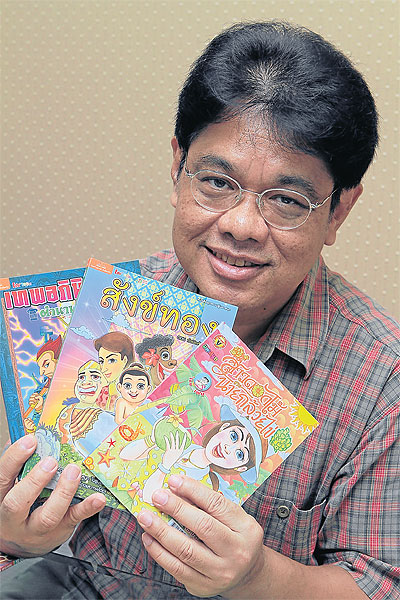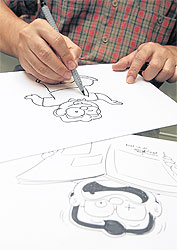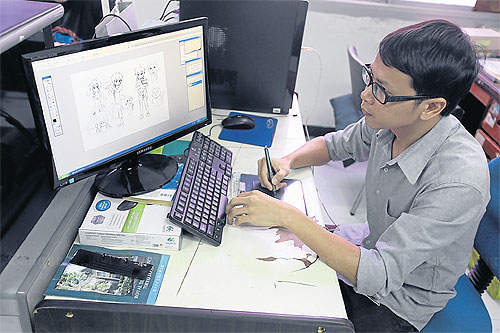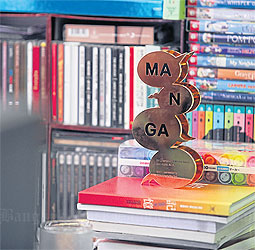Thailand's comic industry is on the rise _ and
there's room for both the classic stories drawn by hand, and those made
with the latest technology. Life speaks to two well-known artists whose
creations are finding fans both here and overseas
 Arifen’s comics from left to right are Miracle Gods of Greek Legends , Thai folktale Sung Tong and Sao Dokmai Ga Nai Gluaykai .
Arifen’s comics from left to right are Miracle Gods of Greek Legends , Thai folktale Sung Tong and Sao Dokmai Ga Nai Gluaykai .The reign of inexpensive, hand-drawn comics from Banlue Publications is not quite over yet, despite new distractions and technologies that may have edged them out as entertainment a long time ago.
The cartoonists of Banlue house are still going strong, with a fan base that, although comes and goes, has lasted throughout the decades. Senior cartoonists from this house still draw and fill the captions by hand onto A4 paper the old-school way; the race against time keeps them computer-free. Whatever screening or colouring is required is added in by the new-gen editorial team at the office.
One of the cartoons that fans would know is the cheery, chubby man with large glasses who is rather round and jointless. He is not complicated to draw and plain, thick black lines _ sans details _ create his friendly facade. The same face takes many different roles: sometimes as a ghost buster, sometimes as a father, or sometimes as a cartoonist. The latter is a reflection that rings closest to life, because that merry and plump character is how Arifen Hazanee, or known as "Pee Fen" to children, sees himself.
Children may not be accustomed to the fact that Arifen is actually not very obese at all in real life, unlike how he draws himself, but are sure to recognise his trademark lakorn parody cartoons and signature that says "Fen Studio". For the past 30 years, Arifen has been drawing comics for Banlue Publications, the same house that also churns out long-standing comics such as Kai Hua Roh, Noo Hin Inter and Pang Pond.
With an unwavering fan base over the years, children throughout the decades hold their breath waiting for his four stories in Sao Dokmai Ga Nai Gluaykai (Flower Girl And Banana Guy) to come out every month. "It's still very sellable. When kids reach high school they move toward novels, but there are new customers born every year. New elementary students are coming up all the time. With its cheap price (15 baht) it's very accessible to all children," says the Yala native. Sao Dokmai has enjoyed a constant sell rate throughout the decades and is doing better than ever with its further distribution in 7-Elevens. With more branches of the convenient store opening up progressively, Arifen's comics are consequently getting more exposure to people in their everyday moments.
 Arifen draws himself doing a funny dance and reading the newspaper.
Arifen draws himself doing a funny dance and reading the newspaper.In fact, the versatility of Thai cartoonists is what Arifen believes to be our distinguishing point from other nations. "Thai cartoonists are different in the sense that we can draw any type of cartoon. We can draw both plotted stories as well as three-box gags unlike ones from other countries, where the gags are drawn by only a specific group, and longer stories by another group." He adds with a laugh, "We are an all-in-one package!"
For Thamonwan Rojanawanichkit, now 22, the Sao Dokmai comics hold a special place in her heart because of the lovable characters and light-heartedness, as opposed to her manga fixes, such as One Piece. "Manga creates much more emotional involvement with the characters, but Sao Dokmai was enjoyable cheap entertainment that I didn't have to put much thinking into."
As the years pass, Arifen's story genres shuffle in and out, but what remains are his ever-popular parodies of lakorn, movies and pop-culture that usually end with a twist. Stories he has poked fun at and created his own amusing direction for in the past include Ban Sai Thong, Mia Luang and Harry Potter, just to name a few. But other than his parodies, Arifen is also famed for his adaptations of mythical legends and epic sagas such as Ramakian, Mahaparata, traditional Thai folk tales and Greek mythologies.
''You may have seen comics about Hercules or Troy, but never before has anyone drawn comics that span since the beginning of the world to the very end of these myths,'' Arifen states. Today, they can be bought in compiled box sets, but in the past, they were limited to one episode per Sao Dokmai issue, and each epic took as long as four years to complete. Regardless, his offering back then has served him for the better as fans had no choice but to buy the next issue, because their curiosity over the cliff-hanger demanded to know what happened next.
Asked why he moved to a completely different ground, Arifen recounts how he has always wanted to read the epics in a cartoon form during his childhood, but didn't have any to buy. ''No one has ever written of the whole epic before. Now that I am a cartoonist, I proposed it to my editor and he has been very kind to approve.'' His editor has a lot of faith and trust in him indeed, as epic comics require more time and effort compared to his lakorn parodies that he struggles to write up every month.
Arifen always whines about his workload in his comics, and it is understandable why he does, despite the fact that he works at home.
''Gags are easy _ three boxes and you're done. It's harder with short stories because I need to organise and write out the plot and dialogue, which is time consuming.''
The 55-year-old cartoonist's move into epics has added even more work to his pile. ''The pictures are more detailed because I have more people to draw in each box, so that means more work. Since it's a comic about myths, there are details in characters, clothes and cities that I have to do further research on. I have more work even though the amount of pages is still the same.''
The scrupulous research for his epics require reading four to five different editions of the classics, since some may omit certain details that still leave him with questions. However, his efforts are well rewarded when teachers tell him how useful his Ramakian and Greek mythology comics are as a teaching aid.
''It makes me very happy to know kids can do their exams thanks to my comics. I want children to have the opportunity to read literature that is hard to digest, in a cartoon form. It's something I've always wanted to do as a cartoonist once in this lifetime, and I keep thinking that new generations need to have a comic form to read, because if you expect them to read the text form, they won't touch it.''
The additional readings may be trying, but cracking jokes is never difficult for Arifen. ''It's like they are a part of me that I can just call on whenever I want.''
He doesn't see himself ever getting tired of this occupation. ''If it's something fun and practically your life, you can't get bored. I guess my heart is still a child! Cartoons have nurtured my childhood and it feeds my brain. I need to use my brain to think of a new plot and find literature to read all the time, and I'm happy getting to do that,'' the amicable cartoonist happily reflects.
He's also very content with reading works by a new crop of cartoonists. ''I do buy the new generation's works to see their line styles and their ideology so I can learn new viewpoints and angles, or else I'd just be reading the same old. I never think of them as competition and to read new and different types [of comics] makes me feel full. It makes me feel good that there isn't just a limited amount of cartoons in our country.''
In real-life, Arifen exhibits a warm and good-humoured persona, just like his comics do. It almost sounds like another joke when he tells us that cartoonists like himself are actually quiet, reserved and very shy.
 Kosin Jeenseekong needs to retouch and add screenings to his drawings
all by himself after they have been scanned into his computer.
Kosin Jeenseekong needs to retouch and add screenings to his drawings
all by himself after they have been scanned into his computer.Confetti showers for Kosin "Moo" Jeenseekong please, for winning the Gold Award from the 6th International Manga Award with his work Listening to the Bell. An honour that is awarded by Japan's Ministry of Foreign Affairs to any manga, this is the second time that a Thai cartoonist has snagged the title against competition from around the world.
The International Manga Award was first initiated in 2007 to honour non-Japanese cartoonists who have contributed to promoting and encouraging the culture of manga for the world to see.
One of the grading criteria that judges use is how cartoonists express themselves into their work to the point that it becomes distinctive to the artist. Kosin's work is a story that follows a broke rocker that tries to earn a place in his father's music school by learning to master traditional Thai instruments. As part of a series, Kosin expects to produce five to six more covers before the story arrives at its end. It usually takes around four months for the completion of one cover, so fans should probably sit back in the meantime.
Like other kids, Kosin grew up with Japanese comics such as Doraemon and Dragon Ball, but also, the neighbour of his childhood home in Din Daeng was none other than the company that produces Kai Hua Roh and Pang Pond _ Banlue Publications.
"Sometimes I would come across some of their cartoonists, such as Pee Tai [creator of Pang Pond], at the mum and pop's store," Kosin recalls fondly. "I just felt that they looked really cool and it was my dream to become like them.
 This year, other applications from Thailand also snagged Silver Award and Bronze Award, with the Gold Award won by Kosin.
This year, other applications from Thailand also snagged Silver Award and Bronze Award, with the Gold Award won by Kosin.Kosin graduated from Srinakharinwirot University with a bachelor's degree in art education and he has been with Siam Inter Multimedia ever since, working in their CartoonThai Studio. This editorial team mainly produces manga, as well as movie tie-ins from movie studio GTH. Kosin's work consists of both team projects, as well as his own titles.
The cartoonist tells us that movie tie-ins tend to be more successful. "They tend to be the most popular because they can appeal to people who don't usually read comics. Movie fans will take interest in it, and it can be sent all across the country to movie premieres."
The fact that manga written by Thai cartoonists occupies very little shelf space as opposed to manga from Japan can be disheartening. "Regardless, Thai comics are getting more acceptance and their development has earned them a spot [on the shelves]. It's still a long way to go before they will ever be as popular as Japanese ones, but it's a big improvement compared to times when they weren't even wanted on the shelves at all." Currently, the print run per title ranges from 3,000 to 20,000 copies, depending on their popularity.
The boom for manga by Thai cartoonists first started around a decade ago, with weekly magazines such as Ckids and Boom first catering home-grown talent to the masses. "In these weeklies, you'd find episodes of Japanese manga, but the requirement was that there must also be a Thai comic in there. This marked the start of Thai comics and since it's a weekly, audiences get a steady dose, which in turn builds awareness for Thai cartoonists. The works would pass their eyes whether they like it or not every week," the 30-year-old explains.
The award he recently received is what feeds him encouragement. "Thai people don't even want to read it, but people in Japan see its value, and it reassures me that what I do isn't wrong. What I do isn't copying _ it still has maintained its distinctiveness. It's a good push for many cartoonists, because after gaining acceptance from the country of origin itself, their work will achieve more popularity and recognition."
Popularity is a slow process that takes time to grow. "The success won't come overnight," Kosin says. "There are so many local talents now, whether in manga, illustration comics or educational ones. It's a good thing have competition because you will always try to develop for the better. If there was a monopoly, Thai comics may not have developed to where it is today _ they would just produce whatever because people had no one else to buy from. It is a drive that pushes us to improve all the time."
Source:http://www.bangkokpost.com/lifestyle/interview/343320/saying-it-with-pictures
Nenhum comentário:
Postar um comentário